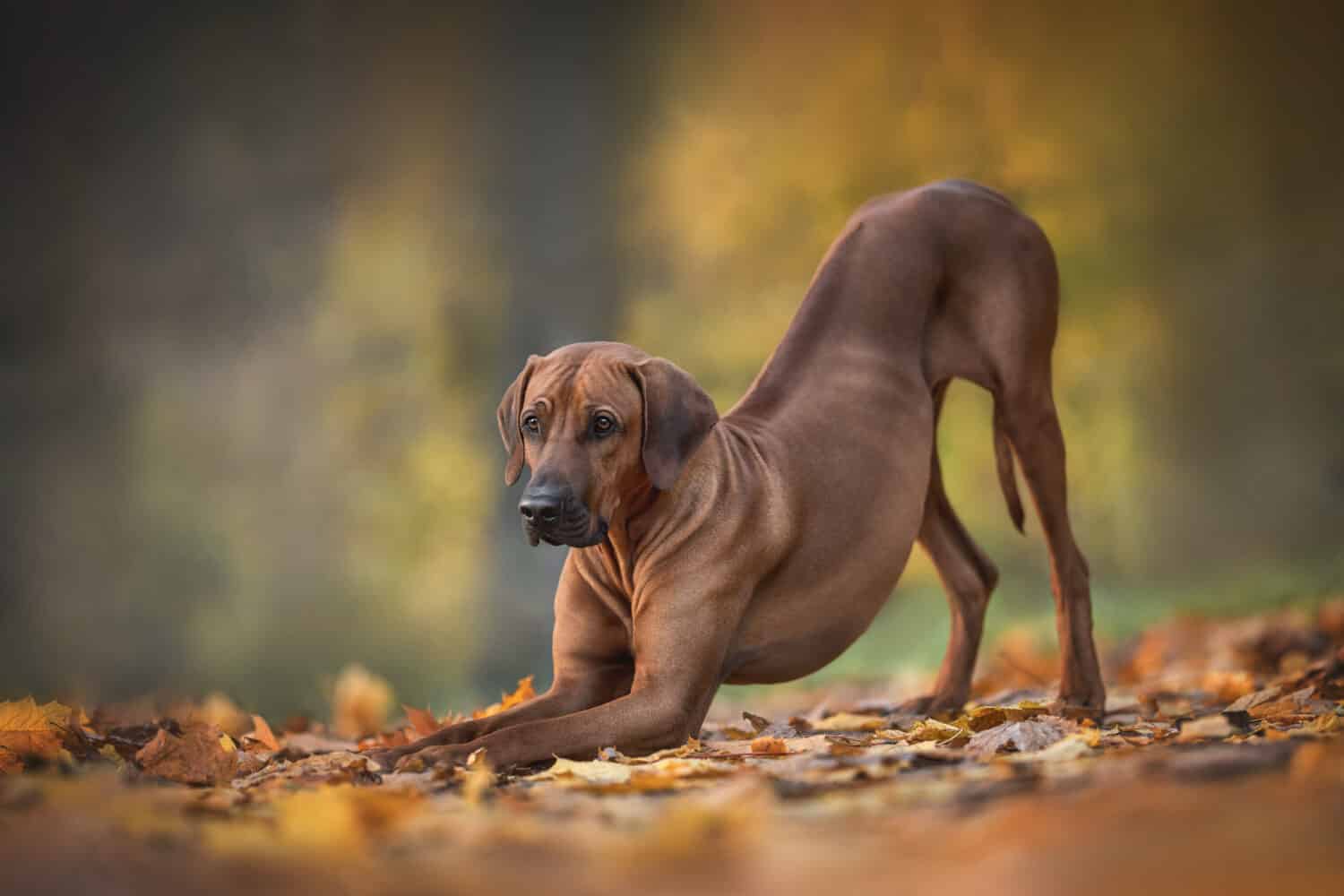Rhodesian Ridgeback Summary
The history of the Rhodesian Ridgeback begins in Africa. This breed is native to South Africa and was used to track down lions. Yes, you read that correctly this breed hunted lions! The Rhodesian Ridgeback is a cross of the native Ridged Khoikhoi and European dog breeds. The name comes from the ridged line running down this breed’s back. This large-breed hunting dog is excellent with kids, is loyal to its owners, and is very affectionate!
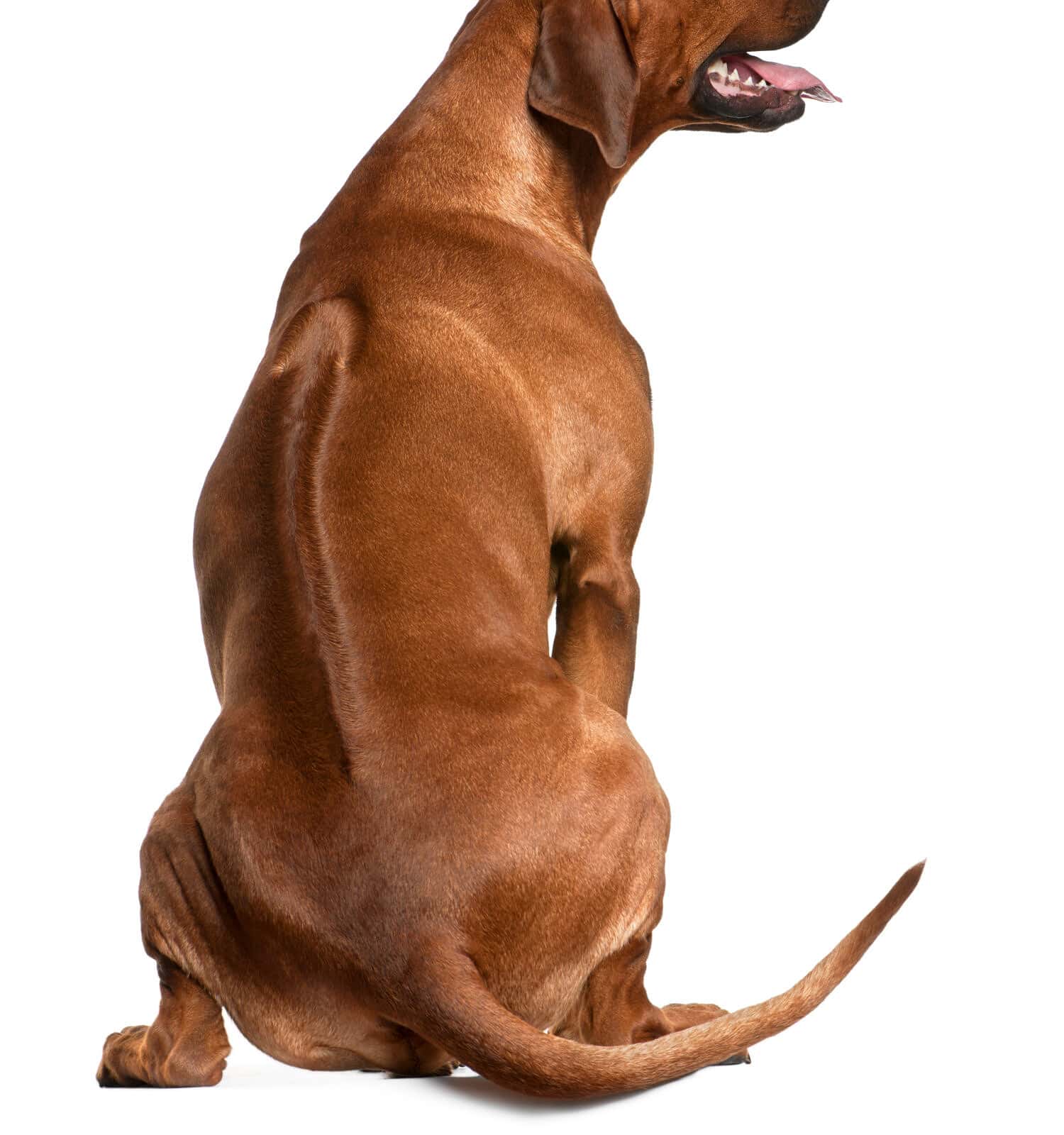
This dog’s unique physical trait is the ridged line that runs down the middle of the back! Hence the name “Ridgeback.”
©Eric Isselee/Shutterstock.com
Growth and Weight
| Age | Male Weight | Female Weight |
| Birth | 2 lbs | 1.1 lbs |
| 1 Month | 11-15 lbs | 9-13 lbs |
| 2 Months | 17 lbs | 16 lbs |
| 3 Months | 30 lbs | 27 lbs |
| 4 Months | 39 lbs | 35 lbs |
| 5 Months | 49 lbs | 44 lbs |
| 6 Months | 55 lbs | 49 lbs |
| 7 Months | 61 lbs | 52 lbs |
| 8 Months | 66 lbs | 58 lbs |
| 9 Months | 69 lbs | 60 lbs |
| 10 Months | 71 lbs | 61 lbs |
| 11 Months | 74 lbs | 64 lbs |
| 12 Months | 77 lbs | 66 lbs |
| 2 Years | 85 lbs | 69 lbs |
When Will My Rhodesian Ridgeback Stop Growing?
Both female and male Rhodesian Ridgebacks usually stop growing around 18 months. Genetics and health status play a role in this breed reaching its expected weight and height. If obtaining this dog from a breeder, check to see how big the parents are!
How Big Will My Rhodesian Ridgeback Be When It Is Fully Grown?
A fully grown, healthy male Rhodesian Ridgeback should stand between 25 and 27 inches and weigh up to 90 lbs. The female should stand between 24 to 26 inches and weigh up to 70 lbs. To ensure your Ridgeback is growing at the correct weight, do monthly weigh-ins to keep track of weight. A veterinarian should evaluate an underweight or overweight Rhodesian Ridgeback to discover any potential underlying health issues.
The Biggest Rhodesian Ridgeback Ever Recorded
There isn’t a world record for the largest Rhodesian Ridgeback; however, males can get up to 90 lbs!
Timeline To Spay Or Neuter Rhodesian Ridgeback
The Rhodesian Ridgeback reaches sexual maturity around ten months of age. The recommended time to spay and neuter dogs, in general, is between 6 to 9 months before the female’s first heat cycle. So, to answer the question, you can have your puppy spayed or neutered as early as six months as long as your veterinarian has given the green light. However, studies have shown large breed dogs should be spayed or neutered closer to the 1-year mark. The reason is this allows them to develop into adulthood fully. If you would like to wait closer to 1 year, make sure to keep your Rhodesian Ridgeback securely indoors to avoid unwanted pregnancies. This breed has an excellent sense of smell. If a male smells a female in heat, they will try their best to get to her. The number of dogs hit by cars are dogs who have not yet been sexually altered.
When Should My Rhodesian Ridgeback Be Housebroken?
Ideally, your Rhodesian Ridgeback should be housebroken by four months old. Potty training should begin around eight weeks when your puppy’s development is starting to form. The key is always consistency and patience. Begin by taking your young puppy outside frequently since they have smaller bladders at this age. Taking them out first thing in the morning, after eating, and before bed will help establish a routine as they age. Avoid giving your puppy water before bedtime so there aren’t accidents in the house. During the potty training stage, keep your puppy in smaller spaces to avoid accidents around the house. The more accidents in the house, the increased chances of urinating in their favorite spots you are unaware of. Some owners like to use puppy pads during this time, but I would not recommend this because of the breed size when fully grown. It is never too late to try to housebreak a Rhodesian Ridgeback, especially if adopting one at an older age. You will need more patience and consistency to break the habit of soiling in the house.
When Should My Rhodesian Ridgeback Stop Eating Puppy Food
Amongst other elements, proper nutrition is vital to the appropriate development of this beautiful breed. Between 0 and 2 months of age, Rhodesian Ridgebacks should still be eating or suckling their mother’s milk. In cases where the mother is not around, puppy formula is a great substitute. Softer food or kibble soaked with water is recommended until your puppy learns to eat without choking. If unsure what to feed this breed, consult a veterinarian on which dog food brands are recommended. Usually, Rhodesian Ridgebacks should consume a high-calorie, large-breed food.
When Will My Rhodesian Ridgeback Start Losing Teeth?
Your Rhodesian Ridgeback will begin losing teeth around four months of age. It is not uncommon for owners not to notice their puppy losing teeth because dogs will swallow their teeth. Do not worry, though. This is normal! During teething, the incisors and molars are the first to go. Between 6 to 9 months of age, the canine teeth will be the last teeth to go. This is also one indicator that veterinarians can use in estimating your puppy’s age if adopting young or to keep track of their development.
When Should I Start Training My Rhodesian Ridgeback
Training For this breed should begin as early as possible, between 6 to 8 weeks of age. Rhodesian Ridgebacks are very smart and stubborn, so starting with basic commands at a young age is recommended. Consistency and positive reinforcement are great starts in developing this unique breed training. Rhodesian Ridgebacks should use the “redirection” method rather than being punished. Punishment, like hitting or yelling, can damage the bond between owner and puppy. The redirecting method allows owners to stop unwanted behaviors without using forceful punishment. For example, if you do not want your puppy chewing on your shoes, remove the shoe from their possession and give them their favorite toy. Keep Training sessions short to prevent your Rhodesian Ridgeback from getting bored and losing interest. Training sessions up to 15 minutes, two times a day, should suffice.
What Cues Should I Start Training My Rhodesian Ridgeback First
Starting with simple clues at a young age is recommended to avoid nasty, unwanted behavior. As your dog learns and grows, you can use more complex commands during training sessions. Below is a list of commands.
- Drop it or leave it. Use these cues whenever your Rhodesian Ridgeback puppy picks up things they shouldn’t. Try to stick with one of the phrases until they understand. This breed can be curious because of the history of hunting. At an adult age, when using this cue, they will understand to leave any object alone during walks.
- Sit. When teaching the command “sit,” first show your puppy how to sit, and when done, reward with praise or a treat. Continue to say the phrase and guide them until they learn what the word means. Hand motion while saying the word will grasp your puppy’s attention.
- Stay. After learning the cue “sit,” “stay” should follow next. Say sit, then say stay as you begin to walk backward.
- Come. After the cue “stay,” “come” should be the next cue. As they age, your puppy will start associating the word’s meaning with the action.
Remember to be patient as your puppy is learning. If you feel defeated or your puppy is not paying attention, remain calm and try again at a different time.
When Will My Rhodesian Ridgeback Calm Down?
As your Rhodesian Ridgeback reaches its full growth status, which is between 12 to 13 months of age, it should start to mellow out. However, this breed is energetic, so calming down can be used interchangeably! Although active, each dog is unique. To keep your energetic dog calm to your liking, exercise and playtime are essential. Mild exercise up to twice daily should suffice the energy release your companion desires. This breed is very affectionate, so you can expect to have a Netflix buddy!
Common Health Issues Your Rhodesian Ridgeback May Experience
Preventative care and routine visits to the veterinarian keep your Rhodesian Ridgeback healthy. However, like other breeds, there are specific health concerns your companion may experience. Below is a list of health problems known for Rhodesian Ridgebacks.
- Hip Dysplasia. A hereditary condition where the hip has not developed correctly.
- Elbow Dysplasia. Similar to hip dysplasia, but occurring in the elbows.
- Dermoid Sinus. A tube-like opening of the skin that presents at birth. The defect can lead to neurological issues and infections.
- Arthritis. A condition occurring with old age or with conditions such as hip dysplasia.
- Dental Disease. If proper dental care is not in place, dental disease causing teeth to rot can occur.
- Eye problems. As pets age, they can develop cataracts or nuclear sclerosis, causing their vision to be poor.
Pictures Of Rhodesian Ridgeback As Puppies

Newborn puppies in the picture above are estimated to be less than 14 days old. Between 10 and 14 days of age, your Rhodesian Ridgeback puppy will begin opening its eyes to view the world!
©olgagorovenko/Shutterstock.com

As Rhodesian Ridgeback puppies grow, they will develop detailed muscle mass.
©Eve Photography/Shutterstock.com
Picture Of Rhodesian Ridgeback At 6 months
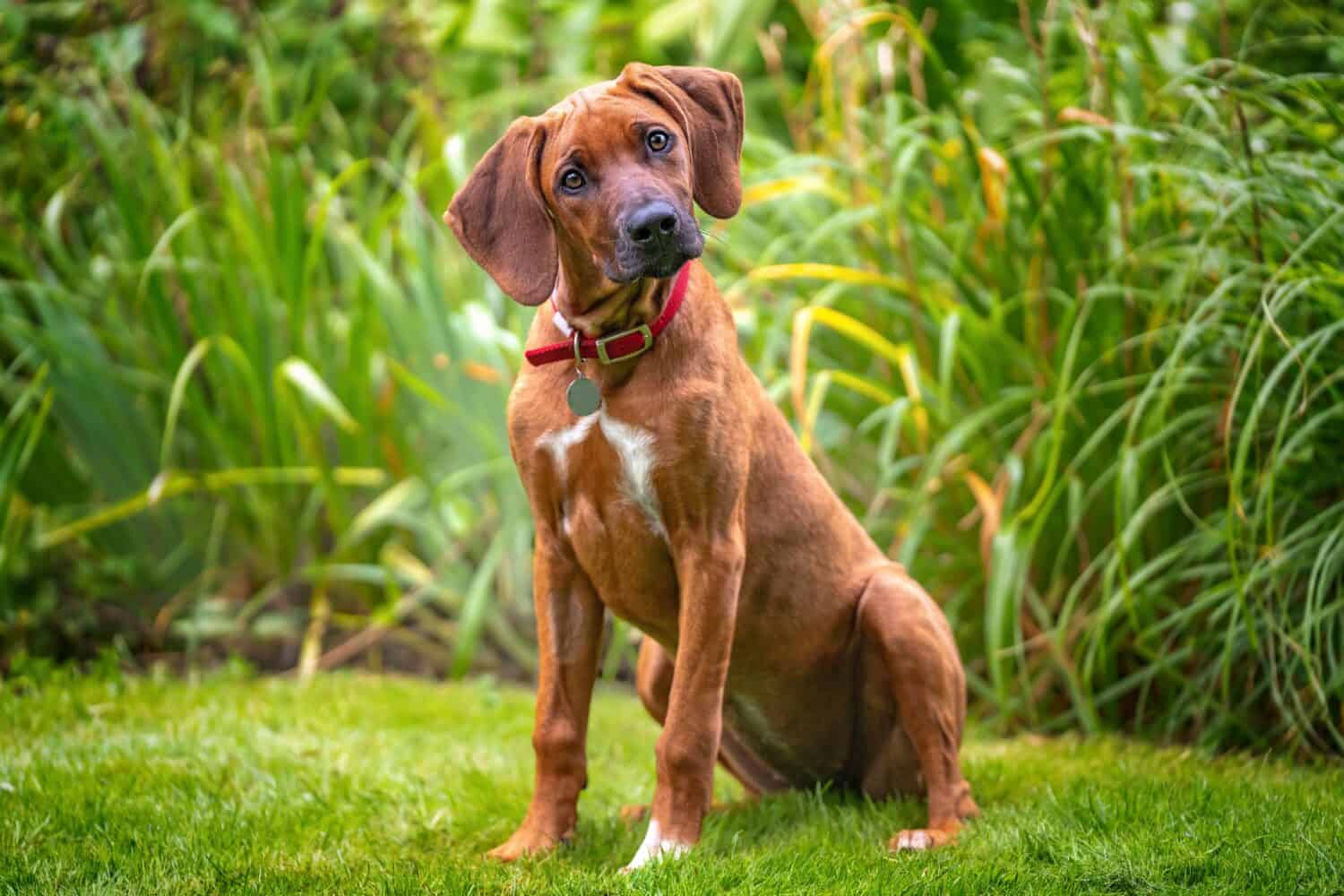
Just at 6 months of age, Rhodesian Ridgebacks appear as if they are hitting a growth spurt. At this age, puppies will weigh between 50 to 60 lbs.
©chrisukphoto/Shutterstock.com
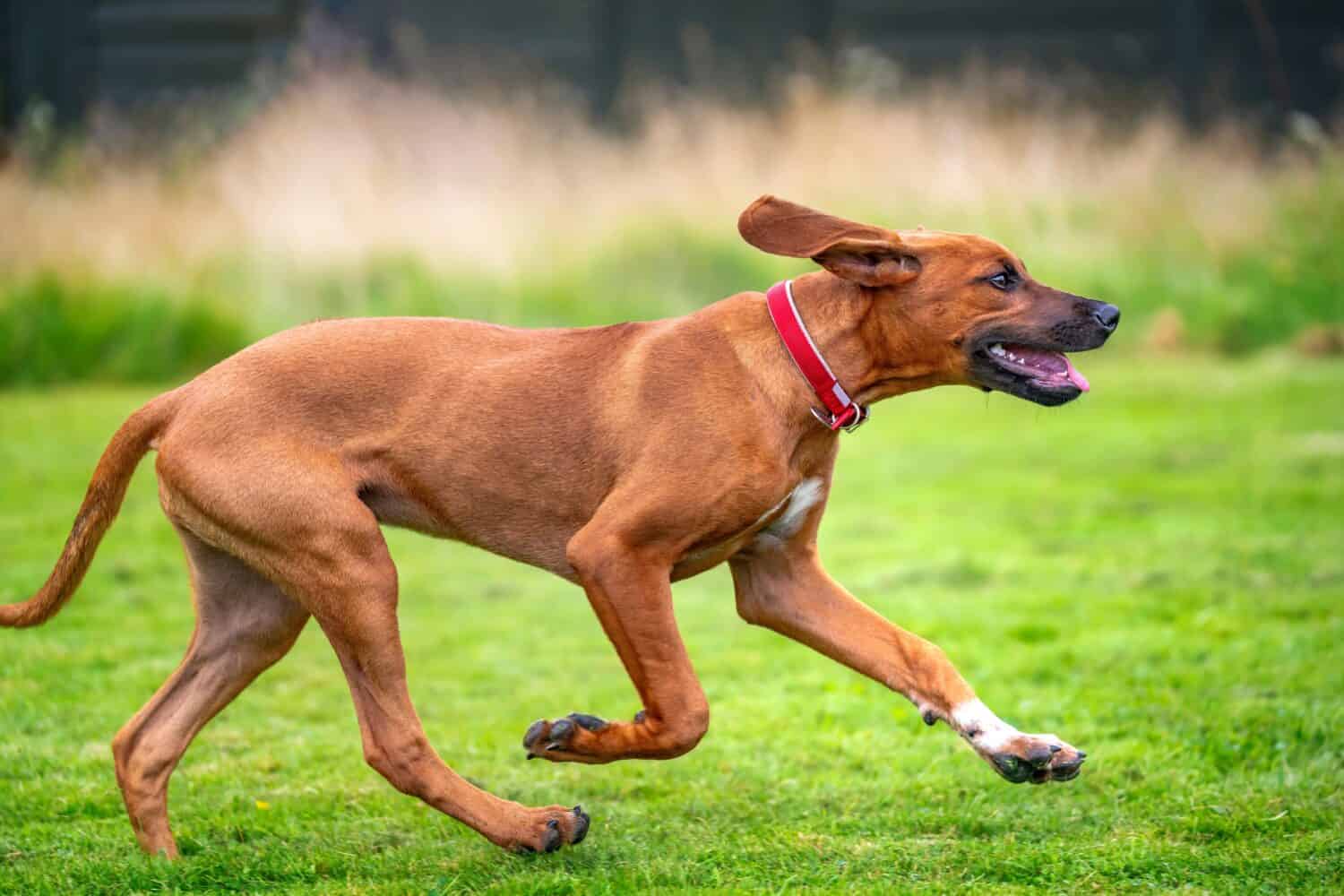
You can see the details in the muscle development these dogs begin to form!
©chrisukphoto/Shutterstock.com
Pictures Of Breed Fully Grown
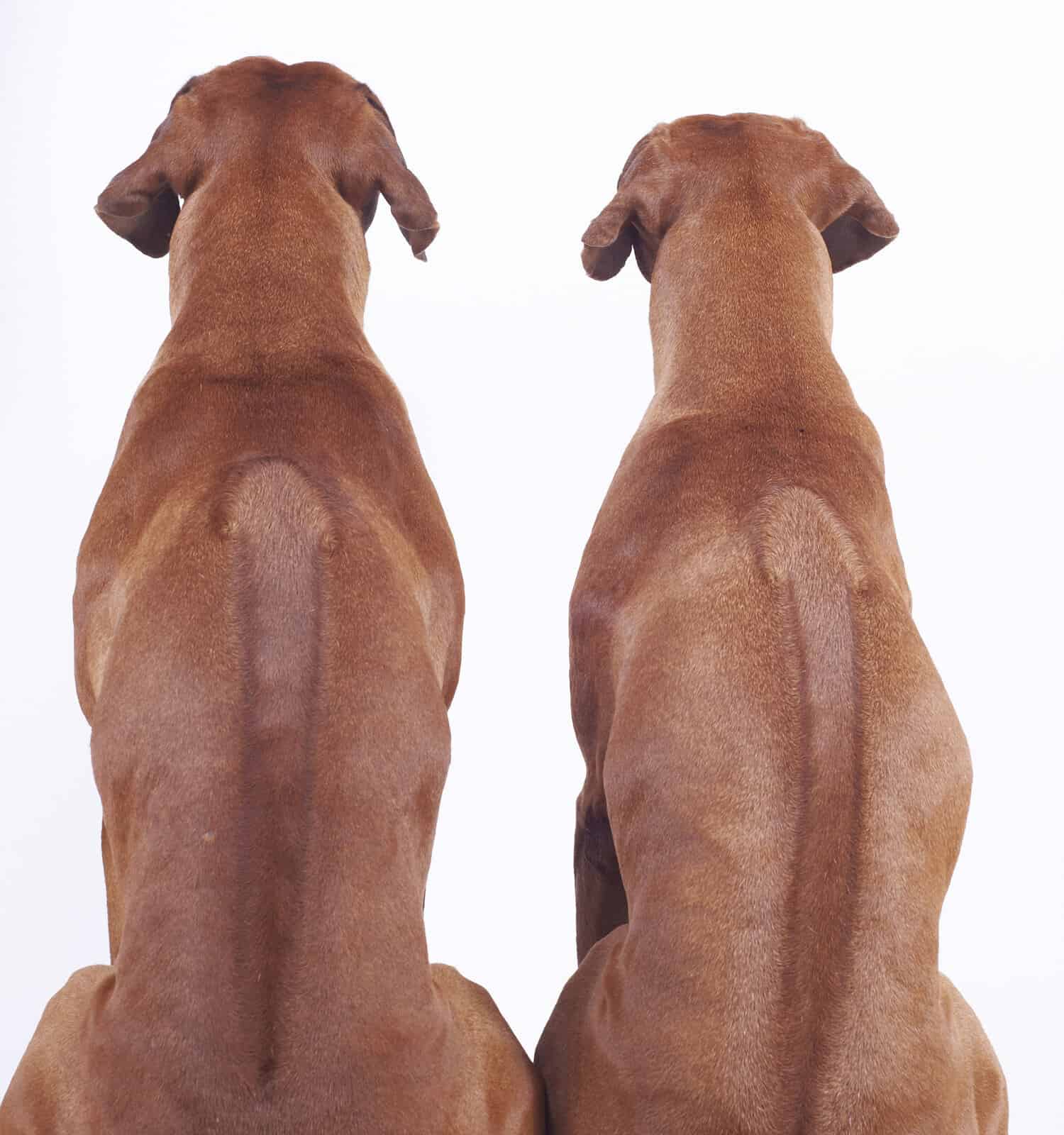
The male Rhodesian Ridgeback is typically larger than the females.
©nancy dressel/Shutterstock.com

Compared to the puppy stage, you can see the physical changes in the face of a Rhodesian Ridgeback.
©Michael J Magee/Shutterstock.com
Other Breeds Similar To The Rhodesian Ridgeback
There is no doubt that Rhodesian Ridgebacks are a unique breed to have. Their physical appearance, history, and personalities help this breed stand out no matter where you go. There are 6 breeds similar to this beautiful dog and here is why.
- Hungarian Vizsla
- Weimaraner
- Broholmer
- Black Mouth Cur
- Dalmation
- Great Dane
Ready to discover the top 10 cutest dog breeds in the entire world?
How about the fastest dogs, the largest dogs and those that are -- quite frankly -- just the kindest dogs on the planet? Each day, AZ Animals sends out lists just like this to our thousands of email subscribers. And the best part? It's FREE. Join today by entering your email below.
Thank you for reading! Have some feedback for us? Contact the AZ Animals editorial team.

